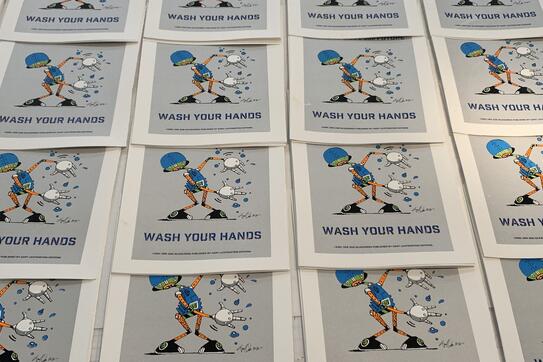Screen printing might not be the first service that comes to mind when thinking of the essential businesses that have jumped in to help with COVID-19 relief efforts, but it’s a vital one. Melissa Marr ’02, managing partner of Gary Lichtenstein Editions, sprang to action when she found out that the studio — which normally produces fine art silkscreen editions made by Gary Lichtenstein, the studio’s namesake and Marr’s husband — was deemed essential. Marr partnered with Urban Pathways, an organization that provides housing and wellness services to the city’s homeless population, to fill their need for approachable, clear signage to post in residences. Through the newfound partnership, Marr was able to organize the creation and dissemination of flyers and posters that can communicate messages from the CDC in an artistic and uplifting way and help keep the city’s homeless population safe during uncertain times.

How did the studio’s partnership with Urban Pathways come about?
When we heard that nonessential businesses would need to close because of COVID-19, we were preparing to deal with the financial consequences of shutting down the business. To our surprise, printmaking was deemed essential in New York due to the overwhelming demand for health and safety signage. I immediately started doing research into nonprofit organizations we could work with and was introduced to Urban Pathways, an organization that offers support services and housing to homeless individuals in New York City and Newark, New Jersey. Urban Pathways runs 15 residential buildings and has over 300 employees working 24/7 in order to get people off the streets and subsequently care for them. In addition to providing homes, the organization also offers counseling, education, health and wellness services, and help with career transitioning. Urban Pathways doesn’t operate conventional shelters. It moves homeless people and at-risk individuals into transitional apartments where social distancing can be maintained — something that has always been a chief component of its business model.

What could your studio provide and why was it so important?
Urban Pathways was limited when it came to communicating urgent health guidelines to its residents. Although the CDC flyers are easy to obtain, print out, and post, they are black & white and generally only 8 ½ x 11 inches. Urban Pathways knew they were not an effective communication tool – not when the individuals they were intended for might not read them and might not be able to understand them. Urban Pathways needed big, bright, bold signage that was capable of delivering critical information quickly and in an unintimidating way. In this case, the critical information was: “Keep Your Distance,” “Wash Your Hands,” “Don’t Forget Your Mask,” and “Actions Shape Our Future.” It’s amazing to be able to focus on something else and focus on someone else’s needs and the needs of the larger community. It allows us to get out of our own heads, turn off the news for a minute, and produce something that people need and that will hopefully make people happy at the same time. Art is vital at a time like this.

What did you create to solve Urban Pathway’s signage challenges?
Working with an artist named Eric Orr, we put together a number of different mockups and sent them over to Urban Pathways. They were an immediate hit. Eric is a Bronx-based artist who is famous for his Max the Robot character. He and Keith Haring were very close friends and used to collaborate together on street art down in the subways – Keith with Radiant Baby and Eric with Max the Robot. The posters deliver meaningful information in a cheerful way and hopefully they bring a little added positivity into these buildings at the same time. In addition to poster production, we are creating a suite of smaller prints for all of the apartments in Urban Pathway’s residences and we just shipped out 420 T-shirts for all of the organization’s frontline workers. From now until the end of June, we are also donating 50 percent of the proceeds from any print sales on our website.

How are you handling staffing with the stay-at-home orders and social distancing?
It's just the two of us who work at the studio – we generally staff up per project. Gary is printing everything himself and we’re working with Eric remotely. We have one assistant, and we've been able to keep him employed through this. He's working from home, of course, but there’s still a lot to do, even from a distance. We were able to put a couple of other freelance employees to work, one of whom actually has a T-shirt press in his garage. This business plan pivot also means that we can continue to support our suppliers.

Will your partnership with Urban Pathways extend past the pandemic?
Yes, we’ve been talking about what this will look like in the next two months and longer term. We know that the social distancing rules might be relaxed slightly over time, but certain messages, like washing your hands, are never going away. We are all discussing additional future signage requirements as things change – as well as other ways we may be able to get involved. We hope that when Urban Pathways is able to reopen their community centers, our team will be able to visit. We’d like to organize a meet and greet where Gary can give a silkscreen demo and perhaps Eric can sign some of the posters. I would love to permanently ramp up services like these for nonprofit entities and I think it will become a central aspect of our business plan moving forward. We are also committed to donating to a much larger group of nonprofits. When things calm down, I plan to reach out to more organizations – I’ve already started compiling a list.
